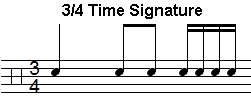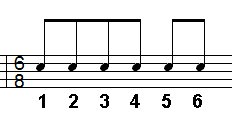What Does Time Signature Mean?
Contents
The time signature is the “fraction” you’ll see at the beginning of drum sheet music, which tells you how to count the beat. In this lesson, I will cover the 4/4 signature, also known as “Common Time”. Later below I’ll get into “Odd” time and direct you to my drum lessons covering how to count time.
The most commonly used time is 4/4 which is found in most all modern “popular” music from the West. 3/4 is another signature you may see or hear a lot of, although it is considered an odd time.

As music progresses and artists strive for originality, you’ll find more unique signature usage like 12/8, 15/16, 7/8, or 5/4 to name just a few.
How To Read Time Signatures
So how do you read these numbers? Treated as a fraction, the top number (numerator) tells you how many beats are in a measure. In other words, it tells you how high to count.
4/4 times counts to 4. The count goes…1-2-3-4.
3/4 counts to 3. As in…1-2-3.
5/4 counts to 5…you get the idea.
The bottom number (denominator) tells you the value of the note. Four signifies quarter notes, 8 for eighth notes and 16 for sixteenth notes.
I cover counting notes in more detail in my lesson on reading drum music below.
Odd Time Signatures
Odd time signatures aren’t found very often in music–or at least in popular tunes. Most of the exercises on my site are tailored towards beginning drummers and are in 4/4.The most common “odd” time is 3/4 found often heard in waltzes, minuets or anything building upon the rhythm created by this pattern.
To call it an odd time signature seems a bit misleading to me since it’s such a common form in different genres. It is also used in some of today’s modern popular rock songs.
5/4 time is one example of a complex signature. These signatures will usually have a prime numerator like 5,7,9,11 and so on. They are often mixed into a song that is in common 4/4 or 3/4 to create a unique change in the feel or tempo of the song. While unusual in the West, these signatures are common in Folk Dance Music of European descent.
6/8 and 2/4 is usually found in jigs, polkas, marching band cadences or waltzes. It has also found it’s way into some modern rock music, but is seldom heard in “Popular” music genres.

12/8 signatures are most often found in the blues genre. It is also referred to as the “Shuffle” feel and can be found in doo-wop tunes. Recently, it has found it’s way into the “mathcore” or “noisecore” genre that uses many odd times and varying signatures throughout each song.
How To Count Using Time Signatures
So, I’ve told you what time signature means, but now what? By now you should know how many beats are in the measure (numerator) and what the notes are (quarters/halfs/whole) using the denominator.That information doesn’t really help you if you don’t know how to count the notes. For help with counting time, see my drum lesson on Reading Drum Music.
Beginner Drum Lessons
How To Read Drum Music



New! Comments
Leave your comments below.